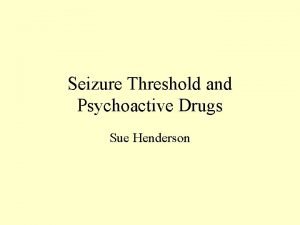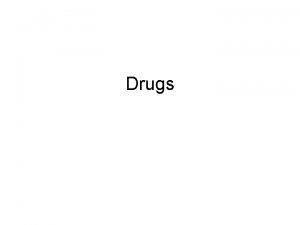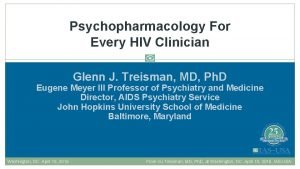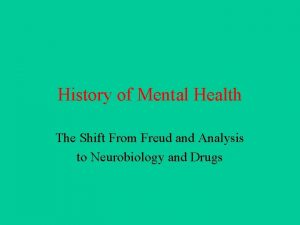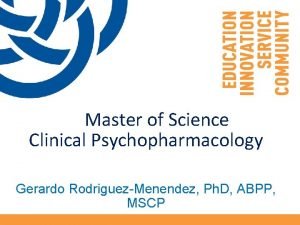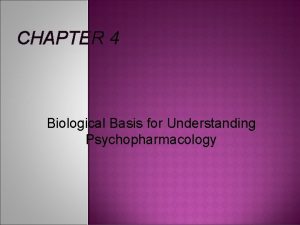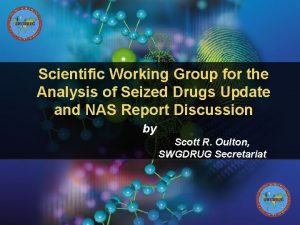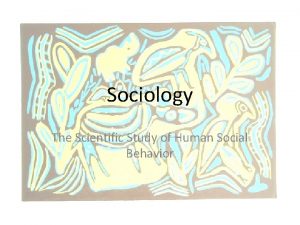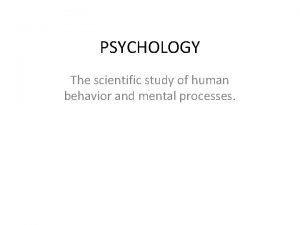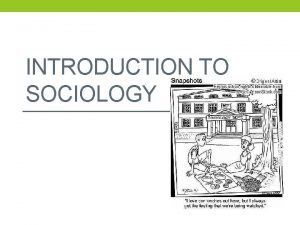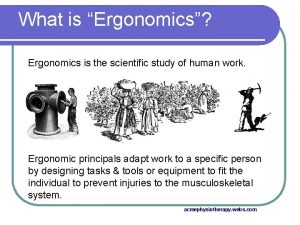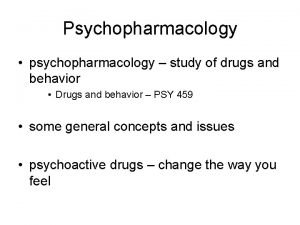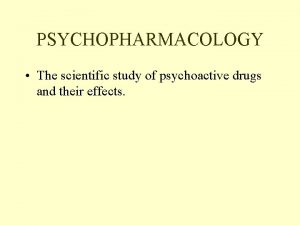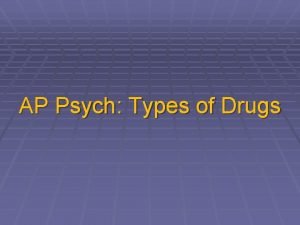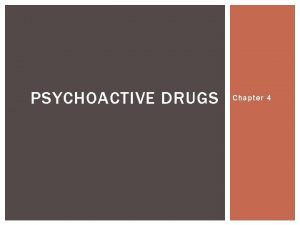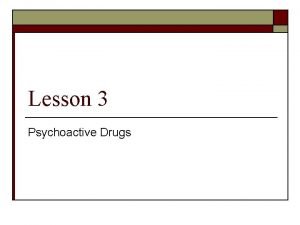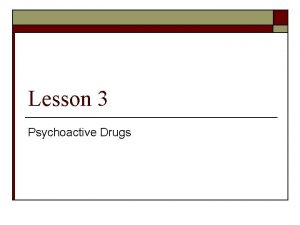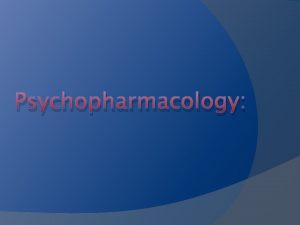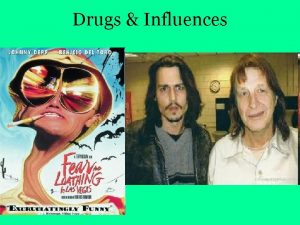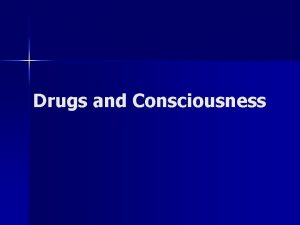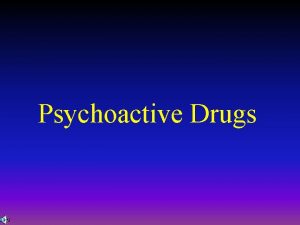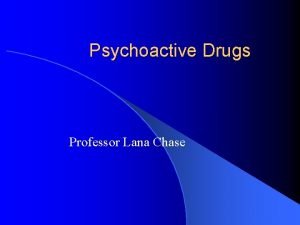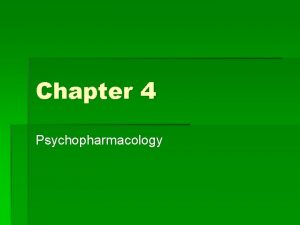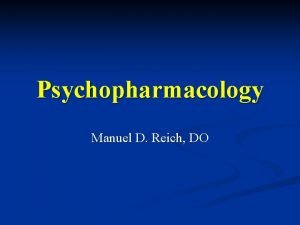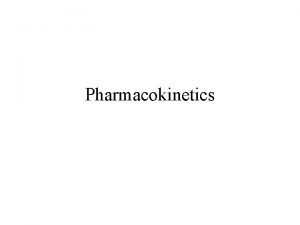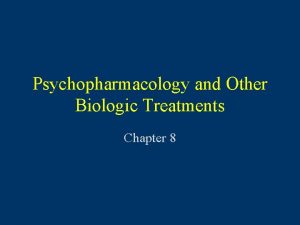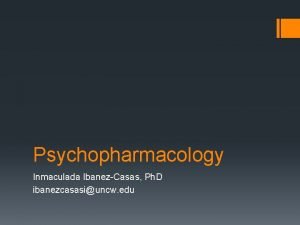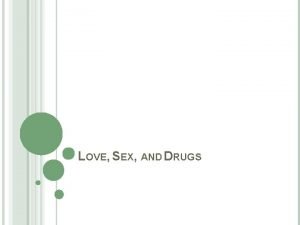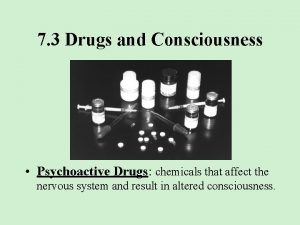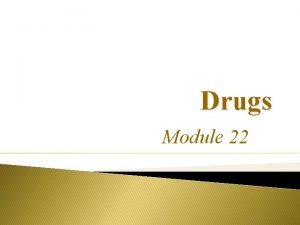PSYCHOPHARMACOLOGY The scientific study of psychoactive drugs and


































- Slides: 34

PSYCHOPHARMACOLOGY • The scientific study of psychoactive drugs and their effects.

General Principles of Psychopharmacology • 1. Drug use in of itself is neither good nor bad…it just is. – Let’s study the phenomena objectively, without preconceived moral judgment. • 2. All drugs have multiple effects – Therapeutic and side-effects may be context dependent. . i. e. SSRIs may be used as a sleep aid, or drowsiness may be seen as a side effect.

General Principles of Psychopharmacology 3. Drugs do not produce effects that are outside the organisms behavioral repertoire. – Instead they magnify or diminish “normal behaviors, or alter the probability or context of responses, etc. . 4. Drug effects are influenced by “nonspecific” factors – In many cases the environmental context may alter a drugs’ effects. The physiological state and Psychological “set” of the individual may also have major influences.

Non-specific Factors • “Set” The physiological and psychological state of the user. Setting The environment and social context in which the drug is taken

Cigarettes to “get going” or to “chill out”

Non-specific drug effects cont’ The “Placebo Effect” Effects NOT based on specific biological actions of the drug, but instead are produced in some way by the Expectations of the user.

Placebo Effect • Placebo- Latin for "I shall please. ” • A placebo is an inert substance, . . sugar pill. . sham medication • Typically about 35% + of subjects are responsive. • Has been effective in treating Pain, anxiety, depression, etc. • Some people may even experience placebo side effects/withdrawal

General Principles of Psychopharmacology Drug Effects are influenced by “Pharmacokinetics

Pharmacokinetics – the influences of route of drug administration, drug absorption, drug distribution, drug transformation, and drug elimination. – These factors influence how fast and how much of a drug gets to its’ sites of action, as well as the duration of a drugs’ effects.

General Principles of Psychopharmacology cont’ • Psychokinetic studies clearly indicate that drug effects are: • 5. Dose-dependent – Consider the effects of mild coffee vs espresso!


General Principles of Psychopharmacology • 6. Drug Effects are Time-Dependent – Consider early intoxication vs late

Early Later Way Late

Drug Effects are influenced by “Pharmacodynamics” • Drug effects on the target tissue • psychoactive drugs produce effects in the central nervous system (CNS) – Many psychoactive drugs bind to “Neurotransmitter receptors” • And alter the activity of brain cells ( neurons) and their functional relationships with other neurons • More on this later

General Principles of Psychopharmacology cont’ • Pharmacodynamic studies clearly indicate that drug effects are: • 7. dependent on the type of drug and its’ site of action

DRUG SITES OF ACTION (more when we cover the nervous system) • Different Psychoactive Drugs affect different Neurotransmitter Systems in the Brain that in turn have different consequences for behavior, thought and mood.

Classical Neurotransmitters • Acetylcholine – In the brain, it appears to be involved in learning/memory, attention as well as sleeping and dreaming.

Classical Neurotransmitters cont’ Dopamine • implicated in movement control – Parkinson’s Disease • Dopamine excess may be involved in Schizophrenia. • involved in the “reward system of the brain. ”

Classical Neurotransmitters cont’ • Norepinephrine – primarily involved in control of alertness/vigilance. – Possible involvement in mood state

Classical Neurotransmitters cont’ • Serotonin –plays a role in the regulation of mood –It also has a role in the control of eating, sleep and arousal.

Classical Neurotransmitters cont’ • Endorphin/ Enkephalin – Modulates the experience of pain – Controls breathing and heart rate, cough reflex, nausea and vomiting – Modulates feelings of euphoria and reward

Classical Neurotransmitters cont’ GABA – Most prevalent inhibitory neurotransmitter in the brain – GABA secreted by “local” interneurons all over the brain. – Implicated in relaxation/anti-anxiety

More on…. Pharmacokinetics • • • Administration Absorption Distribution Biotransformation Excretion

DRUG ADMINISTERED DRUG ABSORBED DRUG DISTRIBUTED DRUG METABOLIZED DRUG ELIMINATED

• • Routes of Administration Oral Intramuscular (IM) Intraperitoneal (IP) Intravenous (IV) Inhalation Intracranial (IC) Intracerebroventricular Topical

Inhalation- a fast route From lungs a direct shot to brain through carotid artery

Absorption • Moving from the site of administration to the bloodstream – Drugs first travel in the bloodstream to get to sites of action – How fast do drugs leave the site of administration? • Route • Acidity/Alkalinity • Absorption relates to bioavailability – The amount of the drug that reaches the bloodstream and/or site of action

Distribution • Refers to factors influencing a drug’s ability to get to its site of action after absorption – First Pass effect • Depends on route of administration – Protein Complexing

Role of the Liver in the “First Pass Effect. ”

BRAIN LUNGS INTRAVENOUS INJECTION RIGHT SIDE OF HEART INHALATION LEFT SIDE OF HEART ORAL LIVER INTESTINE INTRAMUSCULAR INJECTION

Protein complexing Proteins in the bloodstream may bind to the drug and slow or prevent its distribution

Distribution-Depot binding Bone, Fat, Muscle, nonspecific binding of drug. . affects distribution

Distribution-Blood-brain barrier limits drug access to brain

Biotransformation/Metabolism Drug Metabolization – Enzymes break down the drug molecules to prepare them for ELIMINATION Biotranformation occurs mainly in LIVER, but can occur in the nervous system, or in the blood stream as well Enzymes break down drugs into metabolites Metabolites can be active or inactive Some drugs are not transformed at all. .
 Module 25 psychoactive drugs
Module 25 psychoactive drugs Seizure threshold definition
Seizure threshold definition Psychoactive drugs chart
Psychoactive drugs chart Cosmetic psychopharmacology
Cosmetic psychopharmacology Cosmetic psychopharmacology
Cosmetic psychopharmacology Clinical psychopharmacology salary
Clinical psychopharmacology salary Biological basis for understanding psychopharmacology
Biological basis for understanding psychopharmacology Nei master psychopharmacology
Nei master psychopharmacology Scientific working group for the analysis of seized drugs
Scientific working group for the analysis of seized drugs Scientific inquiry vs scientific method
Scientific inquiry vs scientific method How is a scientific law different from a scientific theory?
How is a scientific law different from a scientific theory? India baby tossing
India baby tossing The scientific study of behavior and mental processes
The scientific study of behavior and mental processes Linguistics as a scientific study of language
Linguistics as a scientific study of language Social psychology is the scientific study of:
Social psychology is the scientific study of: Sociology major
Sociology major The scientific study of trees
The scientific study of trees Finished files are the result of years
Finished files are the result of years What is ergonomics
What is ergonomics The scientific study of heredity *
The scientific study of heredity * Hình ảnh bộ gõ cơ thể búng tay
Hình ảnh bộ gõ cơ thể búng tay Lp html
Lp html Bổ thể
Bổ thể Tỉ lệ cơ thể trẻ em
Tỉ lệ cơ thể trẻ em Voi kéo gỗ như thế nào
Voi kéo gỗ như thế nào Tư thế worm breton là gì
Tư thế worm breton là gì Bài hát chúa yêu trần thế alleluia
Bài hát chúa yêu trần thế alleluia Các môn thể thao bắt đầu bằng tiếng đua
Các môn thể thao bắt đầu bằng tiếng đua Thế nào là hệ số cao nhất
Thế nào là hệ số cao nhất Các châu lục và đại dương trên thế giới
Các châu lục và đại dương trên thế giới Cong thức tính động năng
Cong thức tính động năng Trời xanh đây là của chúng ta thể thơ
Trời xanh đây là của chúng ta thể thơ Cách giải mật thư tọa độ
Cách giải mật thư tọa độ Làm thế nào để 102-1=99
Làm thế nào để 102-1=99 độ dài liên kết
độ dài liên kết

